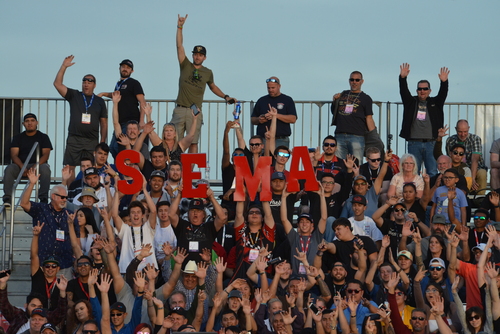LEGISLATIVE AND TECHNICAL AFFAIRS
Putting Out Fire…With Gasoline!
Government Actions Ignite Epic Auto Advocacy Movement
By Colby Martin

and trucks—Save Our Race Cars!
“Save Our Race Cars” is the banner uniting the automotive masses as legislative advocates. The latest phase of the saga to ensure that the Recognizing the Protection of Motorsports (RPM) Act becomes law has shattered previous efforts with viral strength. Many will recall first learning of the unreasonable interpretation of the Clean Air Act by the U.S. Environmental Protection Agency (EPA) in 2016, which has sent a chill through the automotive community ever since. The race to pass the RPM Act has now taken on a groundbreaking pace.
When seeking influence on any public policy such as the RPM Act, the most important measure of horsepower often comes from the voters affected by the law. After all, politicians rely on constituent opinion—that’s us—when making decisions.
For elected officials, the math is simple: More individuals sharing a common issue means more of those enthusiasts weighing in at the polls. Thus, lawmakers are looking to be attached to proposals that are likely to be popular and ultimately enacted into law. An eager electorate holding policymakers accountable is key to swaying favor—a fact that is especially true at the federal level, where incredible volumes are required to cut through the noise.
A passionate and like-minded group of advocates working together can wield huge influence on how we’re governed. Enthusiasts comprise a significant population and are invested in our industry’s political capital and its future. Tapping into that collective energy and channeling the power of their individual votes forms the mission of the SEMA Action Network (SAN). Representing the auto hobby’s legislative voice, the SAN continues to build strength in numbers nationwide. Amid constant threat, this unified legion sticks up for a thriving marketplace when it matters most. More than two decades of legislative victories and communication with hundreds of hobby-friendly lawmakers reinforce why outreach works.
Unlike years past, 2021 brought with it uniquely challenging circumstances for fans of cars and trucks far and wide. Widespread uncertainty, doubt and anger following a series of difficult world events spawned an edgy undercurrent. Tensions were further stoked by numerous cases between the EPA and aftermarket manufacturers.
In one recent lawsuit, the EPA again maintained that once a vehicle has been certified as a street vehicle, it cannot be converted into a racing vehicle, even if it is trailered to the track and is never driven on public roads. While the EPA maintains that it won’t enforce against modified vehicles used on the track, the agency still contends that it has the authority to do so if it chooses.
As a result, the early months of 2021 had the makings of a perfect storm, where the RPM Act was the logical safe harbor: It provides permanent certainty for racers and businesses that produce and sell race parts.
The SAN has experienced an all-out explosion of its contact base. It has grown by 250% overall in recent months and now numbers more than 300,000 individuals ready to weigh in on public policy. At long last, this grassroots force holds a distinct advantage in the eyes of politicians, with far more voters demanding a resolution this year than any other.
Word travels online at light speed, for better and for worse. The digital blitz by racers and fans made the U.S. Congress acutely aware of just how formidable and highly concerned our industry is at present. And it’s ready for battle.
The RPM Act must pass this year, and the odds have never looked more in our industry’s favor. Congress simply can’t ignore the surge of support from racers and fans—the constituents who elected its members to office—demanding action to bring the bill across the finish line for good.
This momentum must be sustained with newly reintroduced legislation eligible for consideration in the current session of Congress. SEMA worked in close coordination with U.S. Representatives Patrick McHenry (R-NC) and Raul Ruiz (D-CA) as they introduced H.R. 3281 along with 46 other original sponsors. A similar effort is underway in the U.S. Senate. Please do your part—keep up the heat!

and trucks—Save Our Race Cars! Photo courtesy: Shutterstock
Fuel The Fire
It’s go time, so don’t let off the accelerator. Your drive is as important as ever, so please sign the letter at SaveOurRacecars.com. Even if you’ve previously contacted your lawmakers about the RPM Act, we need your voice once again now that the bill has officially returned in 2021. The million letters sent are working and resulted in the legislation’s reintroduction this session. Tell your lawmakers to do their part to finally save racing from government threat by supporting and passing the RPM Act into law this year.
Don’t Get Burned
Concerned with protecting your business against emissions enforcement? Find full details and background on the subject in “Is There Something in the Air,” which appeared in the June 2021 issue of SEMA News (www.sema.org/june_2021/something_air).
What Laid the Foundation?
Action by the EPA
In 2015, the EPA proposed a rulemaking that included language suggesting that once a vehicle has been certified as a street vehicle, it cannot be converted into a racing vehicle even if that vehicle is trailered to the track and is never driven on public roads.
Following a huge SEMA-led public outcry, the EPA withdrew the draft provision in April 2016 and noted that it had “no interest in vehicles that begin their existence as normal, EPA-certified production vehicles used on public roads and are then permanently converted to sanctioned competition-use only vehicles.”
However, the EPA continues to assert that the Clean Air Act (CAA) does not allow a motor vehicle to be converted into a racing vehicle used solely for competition.
The agency created a national compliance program and announced that enforcement against high-performance parts, including superchargers, tuners and exhaust systems, is a top priority for this year and beyond.
Clean Air Act
Introduced in 1970, the CAA regulates, among other things, motor vehicles on streets and highways throughout the United States.
The CAA’s anti-tampering provision in Section 203 of the act prohibits selling parts intended for use with or as part of any motor vehicle or motor-vehicle engine where the principal effect of the part or component is to bypass, defeat or render inoperative any device or element of design installed on or in a motor vehicle or motor-vehicle engine in compliance with regulations.
For 45 years, the CAA’s anti-tampering provision applied only to motor vehicles driven on public roads, and street vehicles were allowed to be converted into dedicated race cars that were never driven on the street again.






